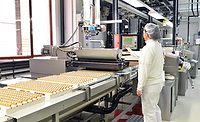On- or at-line monitoring is a great tool to ensure the safety and quality of foods. There are many applications of this technology—food processors monitor temperature in ovens, fryers and other cookers; producers of fresh-cut produce monitor sanitizer levels and pH in flume waters to help ensure the quality and safety of their products; and fryer operators utilize near infrared scanners to continuously monitor fat and moisture in fried snacks.
Now, several major manufacturers of foodservice fryers are installing technology that allows the continuous monitoring of their cooking oil quality. As someone who worked with frying oils for almost 30 years, I wish them well, but hope they are prepared to deal with issues that have plagued the frying industry for many years.
The new monitors are designed to measure total polar materials in frying oil. Polar materials may be defined simply as all non-triglycerides in cooking oil. Fresh oils, prior to the initiation of frying, usually contain 2 to 4 percent polar materials. Once frying starts, oils begin to degrade, a process that is irreversible.
The rate of degradation is a function of many factors including, but not limited to, the cleanliness of the fryer, the type of food being fried (French fries, coated products, meats, etc.), whether the food has been pre-fried, the temperature at which the fryer is being operated, how the unit cycles between batches, whether the oil is filtered or treated and the environment in which frying is done. As an example, ultraviolet lighting can catalyze the oxidation of cooking oils.
The German Society of Fat Research (DGF) published a series of recommendations following the 3rd International Symposium on Deep-Fat Frying in 2000. One recommendation states the best means for confirming the abuse of cooking oils is to monitor total polar materials and polymerized triglycerides (polymers). (The term “abuse” means oil that is no longer fit for frying and may be unsafe to use as cooking oil.)
There are a number of countries around the world that have adopted limits for polar materials in restaurant frying oils to ensure the safety of the frying oil absorbed by the fried foods (see table 1). These values are usually 24 to 25 percent polar materials, and some up to 27 percent.
Realistically, any fryer operator that operates fryers that contain total polar material levels of 16 to 20 percent or above is probably going to go out of business. These oils may not be illegal, but the quality of the food being produced will be poor. According to the first recommendation issued by the DGF in 2000, “The sensory parameters of food is prime quality index.”
This is one of the major issues with the new on- or at-line monitoring systems: What is the best chemical index to use when developing and implementing a program to ensure the quality of the food being fried? There are many different indices that are used and include, but are not limited to:
- Free fatty acid (acid value)
- Total polar materials (TPM)
- Polymerized triglyceride
- Soaps
- Lovibond color
- Anisidine value
- Peroxide value
- Oil stability index (OSI).
Major multinationals in the restaurant and industrial frying industry have invested a lot of money to establish a direct link between the chemical parameters of the oil in fryers and the quality of the food being fried. This means operators must not only monitor different parameters of the degrading oil, they have to relate those parameters to the sensory quality of the food.
The goal is to utilize the oil to yield the best-quality food for the longest period of time. In most cases, a single chemical index is inadequate to properly establish a relationship between food and oil quality. So, the first question will be: “Since companies will be using this, are polar materials the best predictor of food quality?” The answer, as discussed, is probably no.
An even greater challenge for the suppliers of these frying systems will be the fact that one size does not fit all.
When frying oils and monitoring frying oil degradation, every company has a different perception of what constitutes a quality end product. The perfect French fry for company A might be deemed totally unacceptable by company B. The fryer manufacturers are not going to make a blanket statement such as, “French fry producers need to discard oil at reading X and chicken fryers at reading Y.”
Equipment manufacturers will likely need to work with their customers to establish endpoints for discarding oil. Many different test systems have been introduced over the years, but very few have taken hold with foodservice and industrial fryers, because few potential users would make the commitment to determine food quality endpoints. To do this entails a frying study, which is expensive, time consuming and often needs outside expertise to conduct sensory studies and properly analyze the data.
Another obstacle to the adoption of this technology is the test system itself, which is marketed as a tool to monitor total polar materials, but doesn’t precisely do that. It instead measures the dielectric constant of the oil.
This technology was employed in an instrument called the Food Oil Sensor (FOS). This system worked fine in a controlled environment, such as a laboratory, but was adversely affected by a number of factors when utilized in a production or restaurant environment. In addition, this instrument really does not correlate well with TPM compared to when this chemical index is tested using the official method of column chromatography.
There is one final obstacle that must be addressed—cleanliness. Frying oils are a dynamic environment. Anyone who has worked with fryers has probably observed that polymers (brown buildup) begin to form on heating surfaces of the fryer and are deposited at various sections of the fryer. These polymers are removed by using strong caustic cleaners and scrubbing. Plus, the sensor itself is prone to polymer deposits, making the instrument less sensitive, which could adversely affect its performance.
Personally, I would love to see the success of this technology in the industry, but I think there will be many challenges. The equipment manufacturers will need to work with their customers to establish endpoints for their products. This will likely be work intensive as well as expensive, but the equipment manufacturers should be congratulated on their commitment to quality frying.




